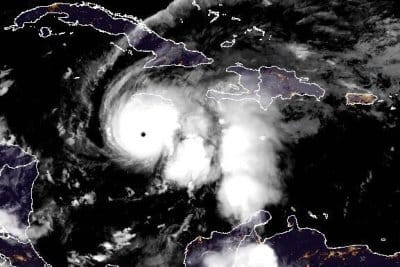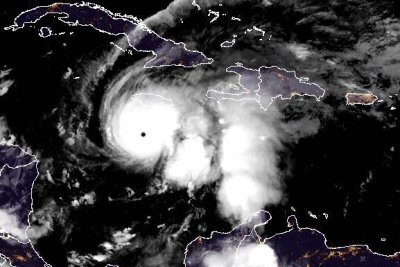‘Seek shelter now,’ forecasters warn as Cat. 4 Melissa nears Jamaica

1 of 3 | Hurricane Melissa, a Category 4 storm, was expected to make landfall in Jamaica on Tuesday morning. Photo courtesy of NOAA
Oct. 27 (UPI) — Forecasters are warning residents of Jamaica to “seek shelter now,” as Melissa, a Category 4 hurricane, was making its way toward the Caribbean island nation early Monday.
The storm was expected to make landfall along Jamaica’s southern coast on Tuesday morning, but the National Hurricane Center reported that the island is already experiencing damaging winds and heavy rainfall that will cause catastrophic and life-threatening flash flooding and landslides.
The hurricane, a Category 4 storm, was located about 130 miles south-southwest of Kingston, Jamaica, and about 315 miles south-southwest of Guantanamo, Cuba, the National Hurricane Center said in its 8 p.m. EDT update.
It had maximum sustained winds of 150 mph and was crawling west at 5 mph.
Forecasters said it was to take a slow westward turn overnight, followed by a north and northeastern turn on Monday and Tuesday.
“On the forecast track, the core of Melissa is expected to move near or over Jamaica tonight and Tuesday, across southeastern Cuba [on] Tuesday night and across the southeastern Bahamas on Wednesday,” the NHC said.
The storm — which became a hurricane Saturday morning and was upgraded to a Category 3 hurricane by Saturday night — continues to gather strength.
Additional intensification of the storm is forecast over the next day or two, after which strengthening is expected to fluctuate.
However, the NHC expects it to be “a powerful major hurricane” when it makes landfall along Jamaica’s southern coast. This would be the strongest direct landfall for the island since records have been kept in the Atlantic Basin.
Either Tuesday night or Wednesday, Melissa is anticipated to make landfall along Cuba’s southeastern coast.
Catastrophic flash flooding and landslides in parts of southern Hispaniola and Jamaica are expected through early next week.
A hurricane warning is in effect for all of Jamaica and for the Cuban provinces of Granma, Santiago de Cuba, Guantanamo, and Holguin.
Hurricane watches are in effect for the southwestern peninsula of Haiti from the border with the Dominican Republic to Port-Au-Prince.
“Seek shelter now,” is the key message the NHC has for Jamaica.
“Damaging winds and heavy rainfall tonight and Monday will cause catastrophic and life-threatening flash flooding and numerous landslides before potentially devastating winds arrive Monday night and Tuesday morning,” NHC forecaster Philippe Papin said in a discussion on the storm.
“Extensive infrastructural damage, long-duration power and communication outages and isolation of communities are expected.”
Accuweather meteorologist Alex Duffus warned that entire communities could be cut off from aid and support for several days.
“Melissa’s slow movement over the mountainous islands greatly increases the risk of catastrophic flash flooding and deadly mudslides,” Duffus said. “This can quickly escalate into a humanitarian crisis, where a large number of people are in need of basic supplies such as food, safe drinking water, housing and medical care.”
Rainfall of 15 to 30 inches through Wednesday is forecast for portions of southern Hispaniola, which includes Haiti and the Dominican Republic, and Jamaica, with a local maximum of 40 inches, the NHC said.
Eastern Cuba is expected to receive rainfall of 6 to 12 inches, with local amounts up to 18 inches into Wednesday.
“Life-threatening storm surge is becoming more likely along the south coast of Jamaica later in the weekend or early next week,” the NHC said.
Peak storm surge heights could reach 9 to 13 feet above ground level, near and to the east of where the center of Melissa makes landfall and are expected to be accompanied by large and destructive waves.
There also is a potential of significant storm surge along the Cuban coast next week.
Melissa is the 13th named storm of the season, and it’s the first in the Caribbean.
This season has seen few storms, resulting in unusually warm Caribbean waters, and the warm water is potential fuel for stronger and more dangerous storms.

